(This Favorite Ride was published in the June 2012 issue of Rider Magazine.)
Story and photos by Kathleen Kemsley
Colorado is best known for its lofty peaks, and rightly so. Those reaching at least 14,000 feet in elevation, known as Fourteeners, number 53 in this not-flat state. A lesser-known side of Colorado is its canyonlands.
On the west slope of the Rocky Mountain Range, sliding toward Utah, are several remarkable canyons. I set out on a sunny August day to explore these hidden chasms carved into red and black rocks.
To get to the Colorado canyon country, I coasted downhill from Red Mountain Pass on the Million Dollar Highway. The first rough gray canyon burst out of the rugged mountains near Ouray, where the Uncompahgre River tore through ancient Precambrian bedrock and flows north toward the Gunnison River. I followed the river’s rushing route through Montrose, and then turned east for 11 curving miles up into Black Canyon of the Gunnison National Park.
The approach did not prepare me for the Black Canyon. Pulling into a turnout inside the park, I stepped to the railing, looked down and gasped involuntarily. Sheer cliffs drop vertically for 2,700 feet. I literally had to grab onto the handrail to keep from pitching forward.
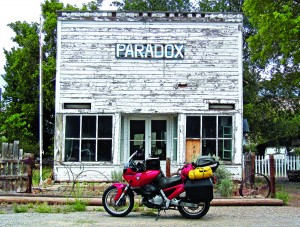
After following a pleasant winding park road out to its end, I rode down the East Portal Road, which is five miles long with a 16-percent grade and leads to the bottom of the Black Canyon. Down at the canyon’s floor, the Gunnison River describes a paradise of still water running deep below the dam. A tiny campground beckoned, but it was too early in the day to camp. Besides, I had learned at the Visitor Center that poison ivy grows lushly along the river, which spells trouble in paradise for me. The BMW agreeably powered me back up the grade to the canyon rim and I resumed my journey north.
Broad agricultural valleys and small towns dot the route from Montrose through Olathe and Delta to Grand Junction. There I crossed the Colorado River and rode up into Colorado National Monument, a preserve of red sandstone and shale eroded into graceful formations. The road through the monument was 20 miles of nonstop twisties, with another dazzling view around every corner. Arriving at the campground an hour before sunset, I paused while setting up the tent to watch virga—rain streaming from clouds that doesn’t reach the ground—slanting over the Book Cliffs, and canyon rocks flaming red in the sunset.
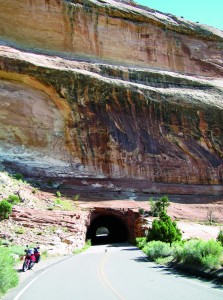
The next morning I backtracked through Grand Junction to reach the Unaweep-Tabeguache Scenic Byway. This sliver of blacktop runs for 90 miles over remote Uncompahgre Plateau. Two creeks named simply East and West drain the region. Near West Creek, in the middle of nowhere, I stopped to look at a ruined structure in the shadow of towering canyon walls. Driggs Mansion was part of an early 1900s effort to homestead and irrigate the isolated parcel. The long-abandoned stone building waits patiently while the elements slowly reclaim it.
Around a curve in the road, a fancy resort appeared without warning. The Gateway Canyons Resort boasts luxury lodging, fine dining, adventure tours, a spa, a car museum, mountain bike and hiking trails, and special events such as music festivals and artists’ retreats. I briefly considered venturing onto its manicured grounds, but riding my 12-year-old motorcycle and wearing my grubby riding clothes it somehow didn’t feel right. From a distance, though, it appears that its location along the banks of the Dolores River, overlooking the Uncompahgre Plateau, is first class.
After Gateway, the scenic byway ran southeast alongside the twisting, turning course of the Dolores River through increasingly stunning red rock canyons. The only traffic on the road was other motorcyclists; I waved at a dozen of them while swooping through long, delicious
curves.
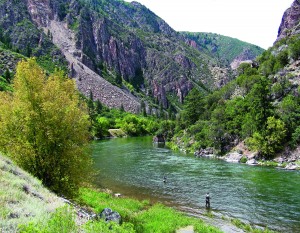
I stopped again at a remarkable historical site farther down the Dolores River Canyon. Peering over the edge of the canyon, I spotted the wooden framework of the Hanging Flume affixed to the smooth red canyon wall with no visible means of support. Exactly how did this gravity-defying flume get there? Little is known about the specifics, but the flume was built as part of a failed attempt to turn a profit by placer mining along the Dolores River. Sections of the skillfully designed flume still cling to the rock to this day, mute testimony to the ingenuity of humans on the trail of gold.
At the end of the Scenic Byway, I turned west to check out one more of western Colorado’s canyons. Paradox Valley lies at the end of 25 miles of seldom-traveled blacktop west of Naturita. I had to know: what is the Paradox?
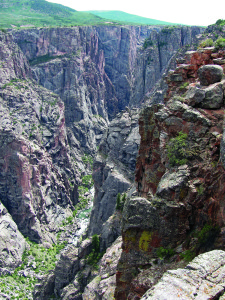
Turns out the answer is geological. Instead of running from one end of the valley to the other, the Dolores River bisects the valley and exits to the west into the rugged La Sal Mountains. There is a logical explanation that involves ancient anticlines, uplift and erosion. Still, it was a jarring visual comparable to an Escher artwork to see the river’s path crosscut the valley.
I left the Paradox Valley to the west, the same way the Dolores River does, and rode through a fierce rainstorm over the mountains into Utah. For the next couple of days I rode the red rock state’s Arches and Canyonlands National Parks. But as I departed those famous and crowded parks, I found myself longing to return to the remote, beautiful and less well-known western slope of the Rocky Mountains, Colorado’s hidden canyonlands.

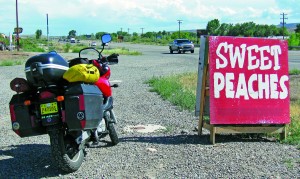
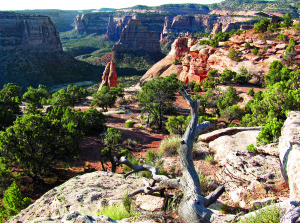
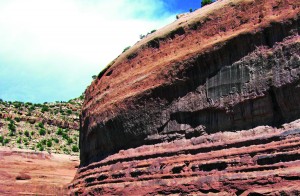
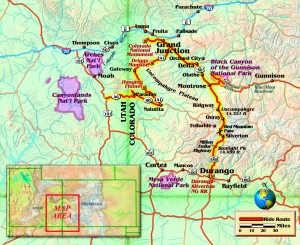







Do not forget the Yampa Bench for a chasms ride.
We have ridden the Million Dollar highway a couple of times, once staying in Durango and once staying in Ourey. Last time we found the Black Canyon by accident. The sign pointing to the turn off was pretty small. The entry gate was the size and shape of a small outhouse. The canyon is magnificent! I’m surprised at how many people have just blown by it. It needs a new publicist.